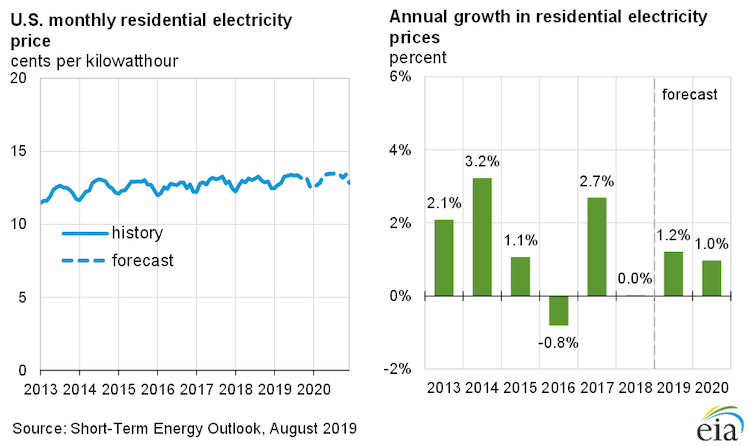The US Energy Information Administration (EIA) has released its Short Term Energy Outlook for 2019 and we have summarized the key highlights for you below.
Electricity, coal, renewables and emissions
EIA expects the share of U.S. total utility-scale electricity generation from natural gas-fired power plants will rise from 34% in 2018 to 37% in 2019 and then decline slightly in 2020.
The share of U.S. generation from coal will average 24% in 2019 and in 2020, down from 28% in 2018. The forecast nuclear share of U.S. generation remains at about 20% in 2019 and in 2020. Hydropower averages a 7% share of total U.S. generation in the forecast for 2019 and 2020, similar to 2018. Wind, solar, and other nonhydropower renewables together provided 10% of U.S. total utility-scale generation in 2018. EIA expects they will provide 10% in 2019 and 12% in 2020.
EIA expects electric power sector demand for coal to fall by 2% in 2020, compared with an expected decline of 15% in 2019. However, planned coal plant retirements will continue to put downward pressure on overall electricity demand for the fuel. Almost 13 gigawatts of coal-fired electricity generation capacity has retired this year or is scheduled to retire by the end of 2020, accounting for 5% of the capacity existing at the end of 2018.
EIA forecasts that renewable fuels, including wind, solar, and hydropower, will collectively produce 18% of U.S. electricity in 2019 and 19% in 2020. EIA expects that annual generation from wind will surpass hydropower generation for the first time in 2019 to become the leading source of renewable electricity generation and maintain that position in 2020.
Results in an EIA forecast that electricity generation from wind power will average 295 billion kilowatthours (kWh) in 2019 and 335 billion kWh in 2020, estimates that are 4% and 7% lower, respectively, than forecast in the July STEO. In addition, the application of hourly dispatch that better models solar incidence lowers the solar electric production forecast by 1.1% in 2019 and by 2.8% in 2020.
EIA forecasts that, after rising by 2.7% in 2018, U.S. energy-related carbon dioxide (CO2) emissions will decline by 2.3% in 2019 and by 0.5% in 2020. In 2019, EIA forecasts that space cooling demand (as measured in cooling degree days) will be lower than in 2018, when it was 13% higher than the previous 10-year (2008–17) average. In addition, in 2019, EIA expects U.S. CO2 emissions to decline because the forecast share of electricity generated from natural gas and renewables is increasing while the forecast share generated from coal, which is a more carbon-intensive energy source, is decreasing.





